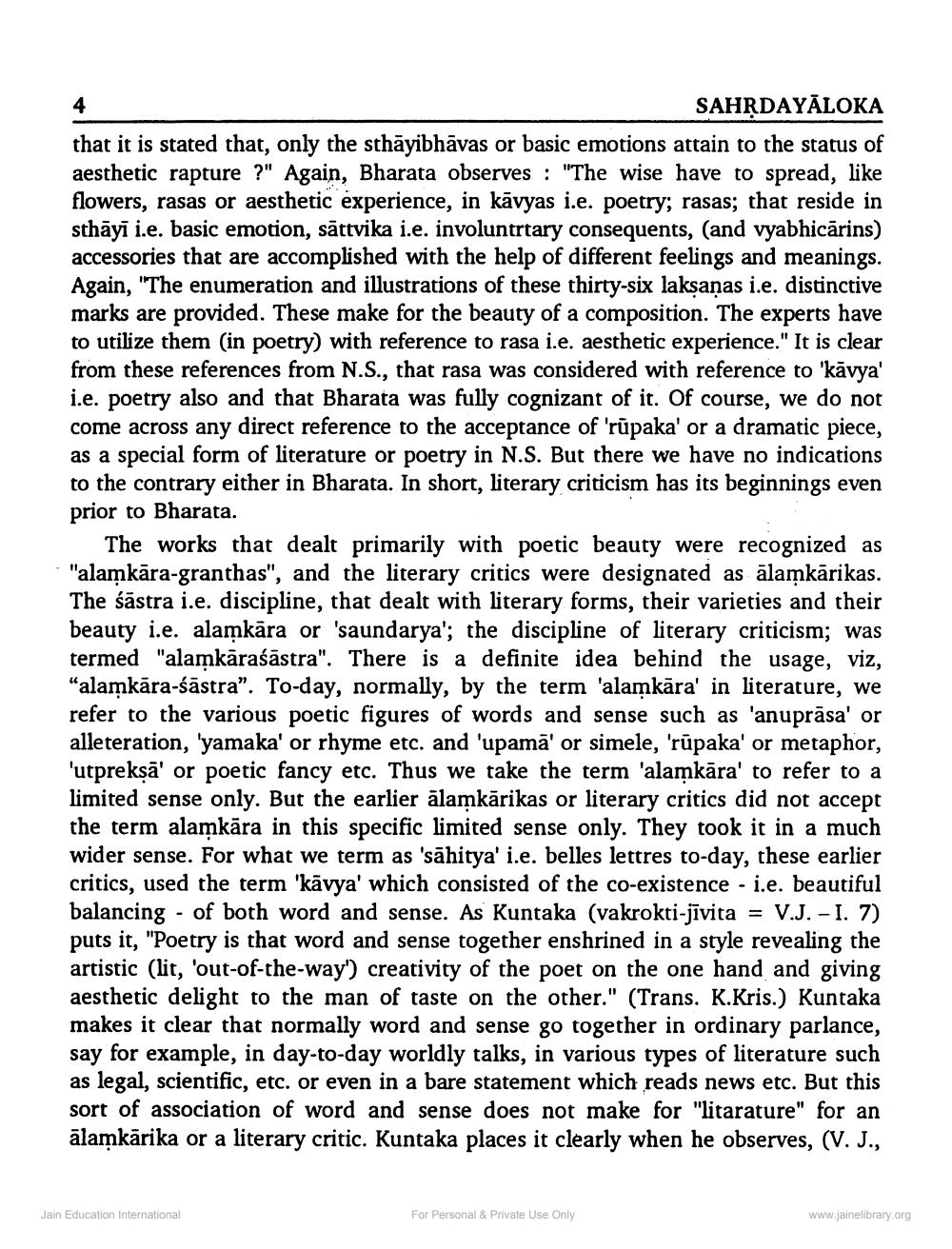________________
SAHRDAYĀLOKA that it is stated that, only the sthāyibhāvas or basic emotions attain to the status of aesthetic rapture ?" Again, Bharata observes : "The wise have to spread, like flowers, rasas or aesthetic experience, in kāvyas i.e. poetry; rasas; that reside in sthāyī i.e. basic emotion, sāttvika i.e. involuntrtary consequents, (and vyabhicārins) accessories that are accomplished with the help of different feelings and meanings. Again, "The enumeration and illustrations of these thirty-six laksanas i.e. distinctive marks are provided. These make for the beauty of a composition. The experts have to utilize them in poetry) with reference to rasa i.e. aesthetic experience." It is clear from these references from N.S., that rasa was considered with reference to 'kāvya' i.e. poetry also and that Bharata was fully cognizant of it. Of course, we do not come across any direct reference to the acceptance of 'rūpaka' or a dramatic piece, as a special form of literature or poetry in N.S. But there we have no indications to the contrary either in Bharata. In short, literary criticism has its beginnings even prior to Bharata.
The works that dealt primarily with poetic beauty were recognized as - "alamkāra-granthas", and the literary critics were designated as ālamkārikas.
The śāstra i.e. discipline, that dealt with literary forms, their varieties and their beauty i.e. alamkāra or 'saundarya'; the discipline of literary criticism; was termed "alamkāraśāstra". There is a definite idea behind the usage, viz, "alamkāra-śāstra". To-day, normally, by the term 'alamkāra' in literature, we refer to the various poetic figures of words and sense such as 'anuprāsa' or alleteration, 'yamaka' or rhyme etc. and 'upamā' or simele, 'rūpaka' or metaphor, 'utpreksā' or poetic fancy etc. Thus we take the term 'alamkāra' to refer to a limited sense only. But the earlier Klamkārikas or literary critics did not accept the term alamkāra in this specific limited sense only. They took it in a much wider sense. For what we term as 'sāhitya' i.e. belles lettres to-day, these earlier critics, used the term 'kavya' which consisted of the co-existence - i.e. beautiful balancing - of both word and sense. As Kuntaka (vakrokti-jīvita = V.J. - I. 7) puts it, "Poetry is that word and sense together enshrined in a style revealing the artistic (lit, 'out-of-the-way') creativity of the poet on the one hand and giving aesthetic delight to the man of taste on the other." (Trans. K.Kris.) Kuntaka makes it clear that normally word and sense go together in ordinary parlance, say for example, in day-to-day worldly talks, in various types of literature such as legal, scientific, etc. or even in a bare statement which reads news etc. But this sort of association of word and sense does not make for "litarature" for an ālamkārika or a literary critic. Kuntaka places it clearly when he observes, (V. J.,
Jain Education International
For Personal & Private Use Only
www.jainelibrary.org




